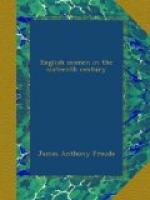In this condition Drake left them for the night, not to rest, but from any quarter to collect, if he could, more food and powder. The snake had been scotched, but not killed. More than half the great fleet were far away, untouched by shot, perhaps able to fight a second battle if they recovered heart. To follow, to drive them on the banks if the wind held, or into the North Sea, anywhere so that he left them no chance of joining hands with Parma again, and to use the time before they had rallied from his blows, that was the present necessity. His own poor fellows were famished and in rags; but neither he nor they had leisure to think of themselves. There was but one thought in the whole of them, to be again in chase of the flying foe. Howard was resolute as Drake. All that was possible was swiftly done. Seymour and the Thames squadron were to stay in the Straits and watch Parma. From every attainable source food and powder were collected for the rest—far short in both ways of what ought to have been, but, as Drake said, ’we were resolved to put on a brag and go on as if we needed nothing.’ Before dawn the admiral and he were again off on the chase.
The brag was unneeded. What man could do had been done, and the rest was left to the elements. Never again could Spanish seamen be brought to face the English guns with Medina Sidonia to lead them. They had a fool at their head. The Invisible Powers in whom they had been taught to trust had deserted them. Their confidence was gone and their spirit broken. Drearily the morning broke on the Duke and his consorts the day after the battle. The Armada had collected in the night. The nor’-wester had freshened to a gale, and they were labouring heavily along, making fatal leeway towards the shoals.
It was St. Lawrence’s Day, Philip’s patron saint, whose shoulder-bone he had lately added to the treasures of the Escurial; but St. Lawrence was as heedless as St. Dominic. The San Martin had but six fathoms under her. Those nearer to the land signalled five, and right before them they could see the brown foam of the breakers curling over the sands, while on their weather-beam, a mile distant and clinging to them like the shadow of death, were the English ships which had pursued them from Plymouth like the dogs of the Furies. The Spanish sailors and soldiers had been without food since the evening when they anchored at Calais. All Sunday they had been at work, no rest allowed them to eat. On the Sunday night they had been stirred out of their sleep by the fire-ships. Monday they had been fighting, and Monday night committing their dead to the sea. Now they seemed advancing directly upon inevitable destruction. As the wind stood there was still room for them to wear and thus escape the banks, but they would then have to face the enemy, who seemed only refraining from attacking them because while they continued on their present course the winds and waves would finish the work without help from




